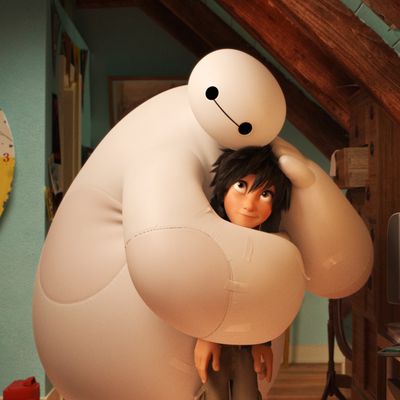
Based on a lesser-known Marvel comic, Disney’s Big Hero 6 is an exciting and touching — at times, a little too touching — tale of families both real and surrogate. But wait, those who’ve seen the trailer might ask. Isn’t this that funny action cartoon with the giant, poofy robot? Well, yes, and therein lies part of the dissonance with this often-wonderful, deceptively strange movie. You could get emotional whiplash watching it.
The film starts off as the story of two orphaned, genius brothers: young Hiro (voiced by Ryan Potter), a smart ne’er-do-well who likes to spend his time hustling at back-alley robot fights; and college student Tadashi (Daniel Henney), a diligent robot designer at the San Fransokyo Institute of Technology. (The boys live in a vaguely sci-fi version of San Francisco, one that blends the moody charm of the port city with Asian-fusion design flourishes.) Desperate to get the brilliant Hiro out of the dangerous and illegal world of bot-fighting, Tadashi introduces him to his fellow grad-school nerds at the Institute. Hiro is inspired to join them, but before he’s able to do so, the entire university — and, tragically, Tadashi himself — is consumed in a calamitous fire.
All that’s left of Tadashi, it seems, is Baymax (voiced by Scott Adsit), a giant, marshmallowlike health robot that the boy had built before his death. Responding to any expression of pain, Baymax sets about trying to diagnose the distraught Hiro, but, not unlike the Terminator, he can’t quite understand “loss” — at least, not yet. Either way, before they can bond too much, the two discover a mysterious, Kabuki-masked figure who may or may not have been involved in the fire, and Hiro realizes he’s found himself a nemesis. Baymax knows over 10,000 medical procedures, but he has no idea how to fight. Not a problem; Hiro just uploads him some kung-fu skills. “Will this help you heal?” Baymax asks the boy. To this gentle robot, even fighting is a therapeutic act. Soon enough, the two are whooshing around town like a crime-fighting team, and Hiro eventually enlists Tadashi’s fellow students from the Institute to help, outfitting them with their own superhero gear.
In its broad strokes, Big Hero 6 has a plot that’s mostly indistinguishable from a Saturday-morning cartoon. It’s fun, action-packed, and adorable. The devil is in the details with this sort of thing, and the film’s ability to patiently work little moments of slapstick is endearing. A scene in which Hiro and Baymax visit a police station to file a report with a skeptical cop, prominent in the film’s trailer, is expertly staged and timed. And the paradoxical nature of Baymax’s powers — he can do just about anything, but he’s been programmed to heal, not hurt — leads our heroes down fun little paths.
But it’s also rare for a film like this to have such a palpable sense of loss. Tadashi’s death itself isn’t so uncommon; that sort of thing happens regularly in kids’ movies and comics. (Think of the dead parents in Frozen, or Uncle Ben’s death in Spider-Man.) But the film keeps returning to this primal hurt. His brother’s death leaves a huge hole in Hiro’s already orphaned heart, and nothing — not even Baymax, really — can quite fill it. We’re reminded of this constantly. It’s even echoed by some later plot details that I’ll avoid spoiling here, except to say that how we deal with loss eventually emerges as the film’s key theme. At the same time, constant reminders of death could be problematic for some younger, more sensitive viewers. I won’t lie; I saw numerous seemingly inconsolable young ‘uns after my screening. It even worked me over a little, too — but in a good way. The loss gives a real urgency to this otherwise-familiar story of a boy and his robot. Here’s a kid who’s lost everything, you start thinking. Please don’t let him lose this, too.


